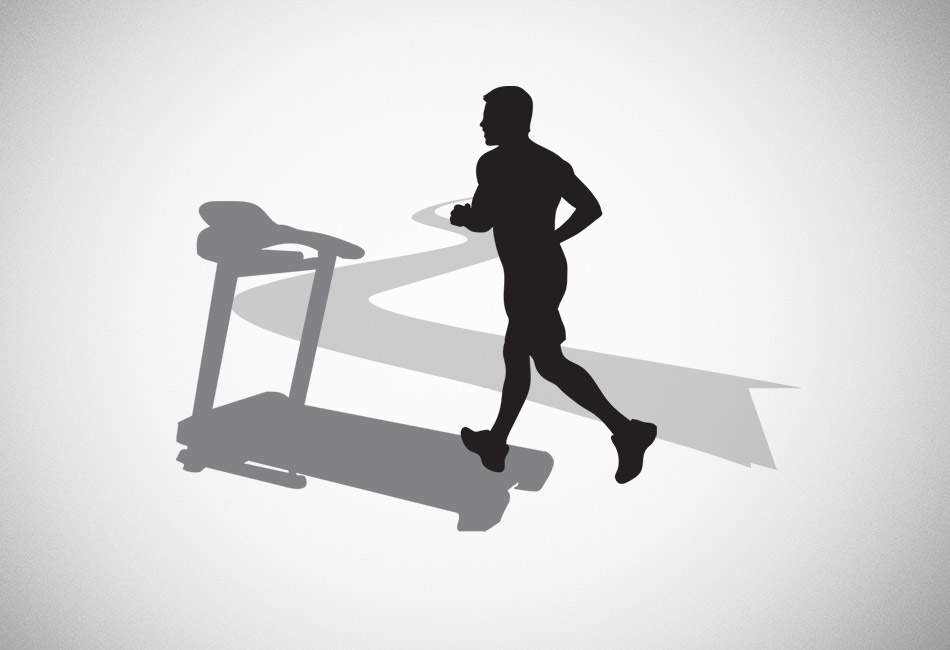When it comes to running on a treadmill the one question that really matters is: how close is it to running outside? Hardcore runners who don’t ever go near a treadmill have maintained that there is a distinct difference which makes treadmill running not “real” running. Most times they base their assessment on the obvious differences we can all see.
Outdoor running requires you to do all the work in order to get from A to B. You provide all the motive power and your legs take all the pounding as you run over the ground. On a treadmill you are standing still and the ‘road’ is moving under you. Because it’s a drive belt you are running on it is perfectly flat and perfectly smooth, plus inside a building there is no wind resistance. When you take all this into consideration you are seemingly not supplying as much power as on an outside road run, so running on a treadmill has to be easier, right?
There are two fields of science we use to address this question properly; Physics and biology. We need physics in order to establish a like-for-like comparison of the energy cost of treadmill versus outdoor running and biology provides the necessary data on the biomechanics involved in each case.
You Use As Much Energy on a Treadmill as you do Running Outside
In a study that involved athletes running on a treadmill with a control group running outside test showed that the VO2 consumption for the two groups running identical distances at similar speeds was exactly the same but in order for the treadmill group to mirror the outside variables they had to do two things: first introduce an incline of 1% in their treadmill setting and second run at speeds that were above 10 km/h. Provided these two parameters were adhered to a treadmill run is as good as an outside one as far as energy cost (i.e. calories burnt is concerned).
Even more interesting is the study on the biomechanics. When we run, we use specific muscle groups and posture. Because the foot hits the ground with some force and there is ground resistance travelling up the leg we have developed pronation to deal with it. Pronation is the way the foot rolls inward when we walk and run. It is part of the natural movement that helps the lower leg deal with shock.
The study of the two groups showed that the biomechanics of treadmill running and outdoor running were virtually the same. Sometimes there seemed to be a slightly more pronounced pronation for treadmill running but that was negligible. So from a biomechanical point of view a run is a run irrespective of where it is being performed.
But that is not the whole story.
The Body Adapts to its Environment
The body is a truly adaptive machine, It has been designed to respond quickly to environmental pressures and adapt to them. This case is no exception. The outside world and the treadmill present two distinct environments each of which functions differently. In the outside world if we want to go faster, in order to accelerate we begin to pump our arms harder and raise our knees higher. Our body begins to change angle in space as we lean forwards and use our feet to push off the ground.
When a comparative study was carried out the researchers discovered that the kinematic angles of hip, knee, ankle and foot for treadmill running overlapped that for outdoors running. The movement was largely the same with any differences observed well within the statistical differences window. The ground forces generated from treadmill and outdoor running were also, surprisingly the same. Despite the fact that treadmills feel cushioned when compared to an outside road surface, there apparently is little difference in how the feedback force travelling up our legs from each stride, feels.
So, if calorie burn and kinematic angles were virtually the same what was different? How did the different environment make the body adapt differently?
That secret is told by the length of the strides. When accelerating we try to take as short a stride as possible because time spent in the air when we no longer have contact with the ground is time during which we decelerate. A road runner who takes long, strides that take his body up in the air is not really capable of accelerating efficiently. For that he needs to take the sort of strides sprinters take which aim for as flat a trajectory as possible.
When we run on a treadmill however we don’t really have to worry about that. As a matter of fact our concern is exactly the opposite. As the treadmill accelerates beneath us we want to be in the air as long as possible between strides in order to keep up. Theoretically we don’t have to run at all on a treadmill., In order to maintain our position on the drive belt we just need to be able to jump high enough each time.
That is also the primary difference between the two. Treadmill running helps us maintain form and fitness and is indistinguishable in its effects from outside running but when it comes to honing running technique and using strategy in our pace to optimize our performance outdoor running has a definite edge.
Sources
A 1% treadmill grade most accurately reflects the energetic cost of outdoor running
A kinematics and kinetic comparison of overground and treadmill running
Comparison between running performance in time trials on track and treadmill
Treadmill vs Overground running:Are they really that different?










